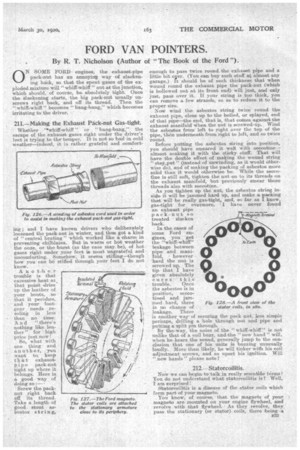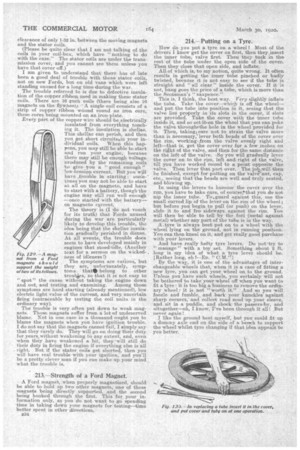FORD VAN POINTERS.
Page 23

Page 24

If you've noticed an error in this article please click here to report it so we can fix it.
By R. T. Nicholson (Author of "The Book of the Ford ").
0 N SOME FORD engines, the exhaust-pipe pack-nut has an annoying way of slackening hack, so that the spent gases of the exploded mixture will " whiff-whiff " out at the junction, which should, of course, ba absolutely tight. Once the slackening starts, the big pack-nut u,sually unscrews right back, and off its thread. Then the "-whiff-whiff " becomes "bang-hang," which becomes irritating to the driver.
211.—Making the Exhaust Pack-nut Gas-tight.
Whether (*whiff-whiff " or " bang-bang," the escape of the exhaust gases right under the• driver's feet is trying to the -temper. It is not so bad in cold weather—indeed, it is rather grateful and comfort
nig ; and I have known drivers who deliberately loosened the pack-nut in winter, and. thus got a kind of " central heating" which worked like a charm in preventing chilblains. But in warm or hot weather the ooze, or the burst (as the case May be), of hot gases right under your feet is most ungrateful and micomforting. Somehow, it seems stifling--though how you can be stifled through your feet I do not know.
An-other trouble is that excessive heat at that point dries up the leather of your beets, so that it perishes, and your footgear needs resoling in less than no time. And " there's nothing like leather" for 'high price just now
So, what with one thingand another, you want to, keep. th at exhaustpipe pack-nut tight up where it belongs. Here is a good way of doing so :— • Screw the packnut right back off its thread. Take a length of good. stout • as bastes string,
enough to pass twice round the exhaust pipe and a little bit oyer. (You can buy such stuff at almost any garage.) it should be of such thickness that when wound round the exhaust pipe the pack-nut (which is hollowed out at its front end) will just, and only jug, pass over it. If your string is too thick, you can remove a few strands, so as to reduce it to the proper size.
Now wind the asbestos string twice round the exhaust pipe, close up to the belled, or splayed, end of that pipe—the end, that is, that comes against the exhaust -manifold When-the nut is screwedelp. Wind the asbestos from left to right over the top of the pipe, then underneath from right to left, and so twice round.
Before putting the asbestos string into position, you should have smeared it well with ..seccotine---almost soaking it with the sticky stuff. That will have the double effect of making the wound string " stay_put " (instead of unwinding, as it would otherwise do), and of making the packing of asbestos, more solid than it would otherwise be While the seccofine is still soft, tighten the nut on to its threads on the exhaust manifold, but previously smear those threads also with aeccotine.
As you tighten up the 'nut, the asbestos -string inside it will be jammed hard up, and make a, packing that will be really gas-tight, and, so far as I know, gas-tight for evermore. I have never found an exhaust pipe pack-nut so .
Marelb liroynal
treated slacken back.
• In the cases of some Ford engines, you get the "whiff whiff" leakage between pipeand manifold, however hard the nut is screwed up. The tip that • I have given absolutely -cures this
trouble. Once the asbestos is in position, seccos tined and jam med hard, there Fig. 128.—A front view of the is no chance of stator coils, in situ.
leakage. There
is another way of securing the pack nut,less simple perhaps, drilling a hole through nut and pipe and putting a split pm through.
By the-way, the noise of the "whiff-whiff" is not unlike that of a coil buzz, and the "new hand" will, when hehears the soUnd, generally jump to the conclusion that one of his units is buzzing unusually loudly. More than likely, he will tinker with his coil adjustment screws, and SO upset his ignition. Will
" new hands" please note? •
. 212.—Statorcoilitis.
Now we can begin-to talk in really scientific terms! You do not understand what -statorcoilitis is ? Well, I• am surprised Ssatorecilitia is a disease of the stator coils which form part Of your magneto.
You know, of course, that the magnets of your magneto are mounted on your engine flywheel, and revolve with -that flywheel. As they revolve, they pans the stationary (or stator) coils, there being -a clearance of only 1-32 in. between the moving magnets and the stator coils, (Please be quite clear that I am not talking of the coils in your coil-box which have "nothing to do with the case." The stator coils are under the transmission cover, and you cannot see 'them unless you have that cover off.) I am given to understand that there has of late been a good deal of trouble with these stator coils, not on new Fords, but on old vans which were left standing unused for a long time during the war. The trouble referred to is due to defective insulation of the copper ribbon. used in making these stator coils. There are 16 such coils (there being also la magnets on the flywheel). 'A single coil consists of a strip of copper ribbon -wound round an iron core, these cores being mounted on an iron.plate.
Every part of the copper wire should haelectrically insulated from everything touching it. The insulation is shellac. This shellac can perish, and then you get short circuitsAin your in-. dividual coils. When this happens, you may still 'be able to start and run your engine, because there may still be enough voltage produced by the remaining coils to give. you a "good enough" low-tension current. But you will have ;trouble in starting : sometimes you may not be able to start 'at all on the magneto, and have to start with a battery, though-the engine may still run well enough —once started with the battery— on magneto current,
The theory' is. (I do not vouch for its truth) that Fords unused during the war are particularly likely to develop this trouble, the idea being that the shellac insulation gradually perished in disuse. At all events, the trouble does seem to have developed mainly in engines that stooclidle. (Another text for a sermon on the wickedness of idleness!) The symptoms are various, but they, are, unfortunately, symptoms that belong to other trouhes, so that it is not easy to " spot" the cause without taking the engine down. and out, and testing and examining. Among those symptoms are hard starting (already mentioned), low• electric light value of the current, and very. uncertain firing (untraceable by testing the coil units in the ordinary way). The trouble is very often pat down to weak magnets. Those magnets suffer frorn.a lot of undeserved blame. Not in one case in a thousand ought you to blame the magnets when you have ignition trouble. I do not say that the magnets cannot fail, I simply say that they rarely do: They will go on doing their duty for years without weakening to any extent, and, even when they have weakened a bit, they -will still do their duty in firing the engine if everything else is -all right. But if the stator coils get shorted, then you Will have real trouble With your ignition, and you'll be a pretty clever man if you can make up your mind what the trouble is. Fig. 129.—A magnet from a Ford magneto should support the weight of two of its fellows.
2I3.--Strength of a Ford Magnet.
A Ford magnet. when properly magnetized, should be able to hold up two other magnets, one of those magnets being directly supported. and the second being hooked through the first. This for your information only, as you do not want to go spending time in taking down your magnets for testing—time better spent in other directions.
B34
2I4.—Putting on a Tyre.
How do you put a tyre on a wheel ? Most of the driverI. know get the cover on first, then theTinsert the inner tube, valve first. Then they tuck in the rest of the tube under the open side of the cover. Then they close that open side, and inflate.
Alhof which is, to my notion, quite wrong. It often results in. getting the inner tube pinched or badly twisted, because it is not easy to see if the tube is straight and "all clear" inside the cover. If it is not, bang goes the price of a tube, which is more than the Scotsman's " saxpence."
This is, I think, the best way. Very slightly inflate the tube. Take the cover—which is off the wheel— and put the -tube into position in it, seeing that the valve lies properly in 'its slots in the coyer, if slots are provided. Take the cover with the inner tube inside it, and so set it, on the wheel that-you can poke the valve through4the hole in the wheel provided for it. Then, taking i care not to strain the valve more than is necessary, lever both beads of the cover over the rim, working' from the valve evenly right and left—that is, get the cover over for a few inches on the right of the valve, .and then for the same distance on the left of the valve. So you will gradually lever the cover on to the rim, left and right of the valve, till you have worked round to a point opposite the valve. Then lever that part over. The jobavill then be finished, except for putting on the valve'nut, cap, etc.; seeing that the beads are well arid truly seated, and blowing up. In using the levers to humour the cover over the rim, you have to take care, of .course7-that you do not nip the inner tube. To,guard against this, use the small curved lip of the lever on the rim of the wheel ; but before you begin to pull (or push) on the lever, slide it to and fro sideways, against the rim. You will then be able to tell -by the feel (metal against metal) whether any part of the tube -is in' the way.
A Ayre is always best put on to a wheel with the wheel lying on the ground, not in running position. You can. then kneel on it, and get really good purchase with your'levers.
And have really hefty tyre levers. Do n.ot:try to " manage " with a toy set. Something about 2 ft. long is my idea of what a tyre lever should be. [Rather long, eh 1—En. " 0.M.' 13y the way, it is one of the advantages of interchangeable wheels that, when it is a case of fitting a new tyre, you can get your wheel onto the ground. Unless you have such wheels, you certainly will not be bothered to takeyour wheel off -w-hen you want to fit a lyre: it is too big a business to remove the ordinary wheel : it is not "worth it." -And so you will foozle and fumble,, and hark your knuckles' against sharp corners, and collect road mud up your sleeve, -and. sit in a puddle, and shack the passers-by, and altogether—oh, I know, I've been through it all 1 But never again!
,I like the ground best myself, :but You could fit up a dummy axle end on the side of .a bench to support the wheel whilst tyre changing if that idea appeals to you better.


























